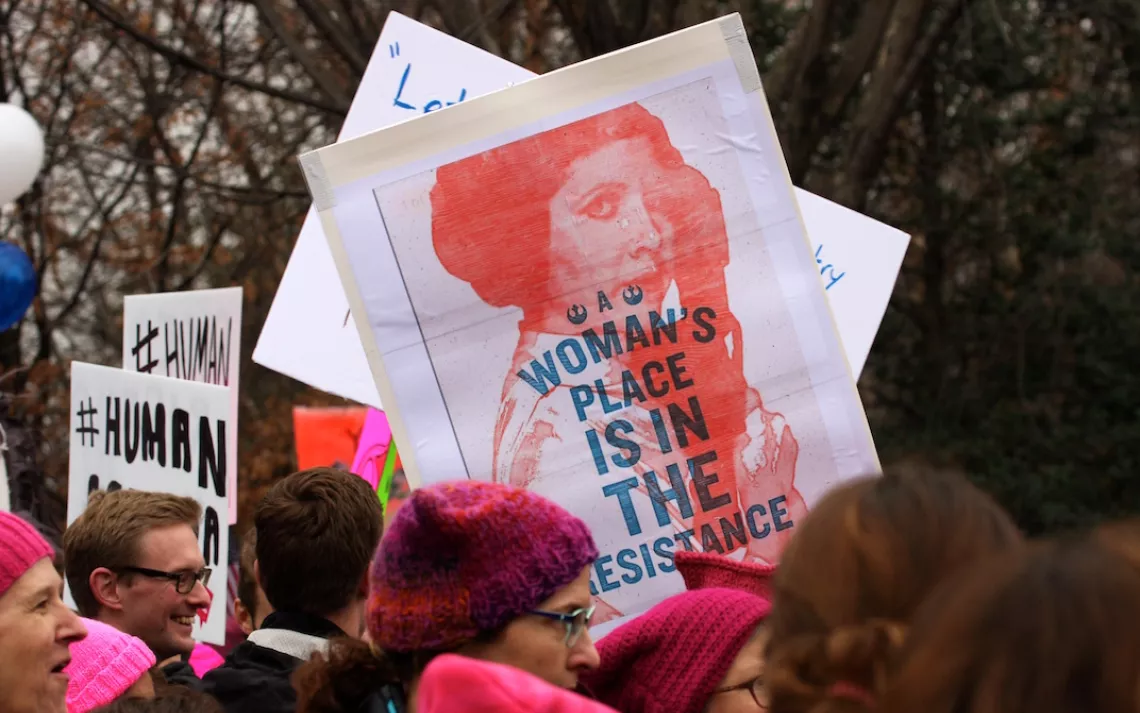Is the Day Without a Woman Strike Symbolic? Yes, But It’s Also Effective.
Organizers of the Women’s March call for women to not show up on March 8

Photo by Javier Sierra.
On January 21, millions of people demonstrated across the United States and around the world against Donald Trump’s presidency and in support of gender equality. Now, to continue that momentum, the organizers of the Women’s March are calling for a national “Day Without a Woman” strike on Wednesday, March 8. They are urging women and their allies to take action to highlight “the enormous value that women of all backgrounds add to our socio-economic system—while receiving lower wages and experiencing greater inequities, vulnerability to discrimination, sexual harassment, and job insecurity.”
But even for dedicated activists, it can be trickier to participate in a strike on a weekday than a weekend protest march. Many women can’t afford not to be paid, or may risk losing their job if they miss work. Organizers acknowledge as much and on their website, suggest other ways of getting involved, such as wearing red and not spending money.
Women who can exercise the right to strike may still see it as a difficult decision precisely because of the kind of work that so many women do. For example, 76 percent of public school teachers in the United States are women, according to the National Center for Education Statistics. Teachers who want to participate have to contend with the fact that if they walk out, their students will be impacted the most.
So far the strike has generated enough interest that two school districts—one in Virginia and one in North Carolina—have canceled school for the day, saying they can’t cope logistically with so many absent teachers.
But many teachers who support the idea of a strike are still planning to show up to work. Lura Lunkenheimer is President of Peaceful Schools, an organization based in Syracuse, New York, which is dedicated to promoting socio-emotional development and conflict resolution in schools. “Staying home from the workforce would cause disruption to our students, who are not the intended recipients of the message,” she told Sierra in an email. “Many of my colleagues are choosing to wear red in solidarity with the events taking place across the country.”
So is the strike merely symbolic? It’s important to view it in the larger context of the activism surging across the country—the spontaneous demonstrations at airports in response to the travel ban, the raucous town hall meetings with representatives, the Day Without an Immigrant strike on February 16, and the ongoing #GrabYourWallet boycott of businesses affiliated with the Trump family. No one action affects change on its own, but taken together, they amount to major pushback on the Trump administration’s agenda. Also, as Emily Crockett of Vox points out, visible gestures (like wearing red) help to create “a virtuous cycle that attracts more and more new activists who are fired up for women’s rights.”
The organizers of the Women’s March clearly see the strike as a way to continue engaging those who are new to activism and educating them about different approaches to agitating for change. In a Washington Post article, Linda Sarsour, the national co-chair of the Women’s March explained, “It’s another strategy. It was not going to be comfortable for everyone.”
The Day Without a Women Strike also exists in a global context, coinciding with an International Women’s Strike being held in more than 30 countries under the banner of “feminism for the 99 percent.” Organizers of that effort say that while Trump’s misogyny was a trigger for the current groundswell of activism, the conditions that led to his presidency have existed for decades and need to be addressed worldwide.
Furthermore, March 8 is International Women’s Day. The United Nations has declared this year’s theme to be "Women in the Changing World of Work: Planet 50-50 by 2030" in order to draw attention to gender inequality in the work force across the globe. According to the UN Women website, “...An overwhelming majority of women are in the informal economy, subsidizing care and domestic work, and concentrated in lower-paid, lower-skill occupations with little or no social protection.” UN experts argue that achieving gender equality at work is necessary for sustainable development and for confronting challenges of the 21st century, like that of climate change.
Elizabeth Boyd, a teacher at a low-income high school in Houston, is conflicted about whether to strike. She supported her students when they walked out of class for the Day Without an Immigrant strike, but doesn’t feel she can walk out on them. She plans to wear red and not spend any money, and she’s also made a point of modeling activism in other ways. She taught her students how to figure out who their representative is and write to them. “I don’t care what they write, as long as they write,” she says. So far her students have generated 400 postcards.
Ultimately, critics may write the strike off as merely symbolic, but if women like Boyd (as well as men) see it as an opportunity to heed a broader call to action, it certainly won’t be ineffectual.
 The Magazine of The Sierra Club
The Magazine of The Sierra Club



